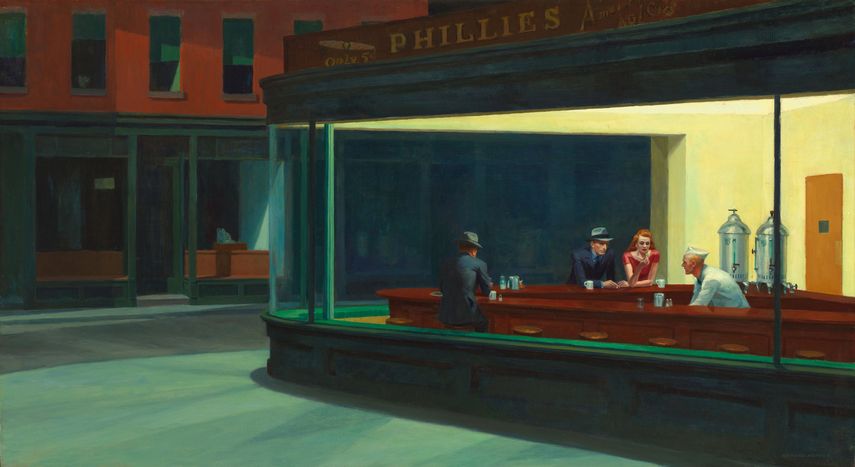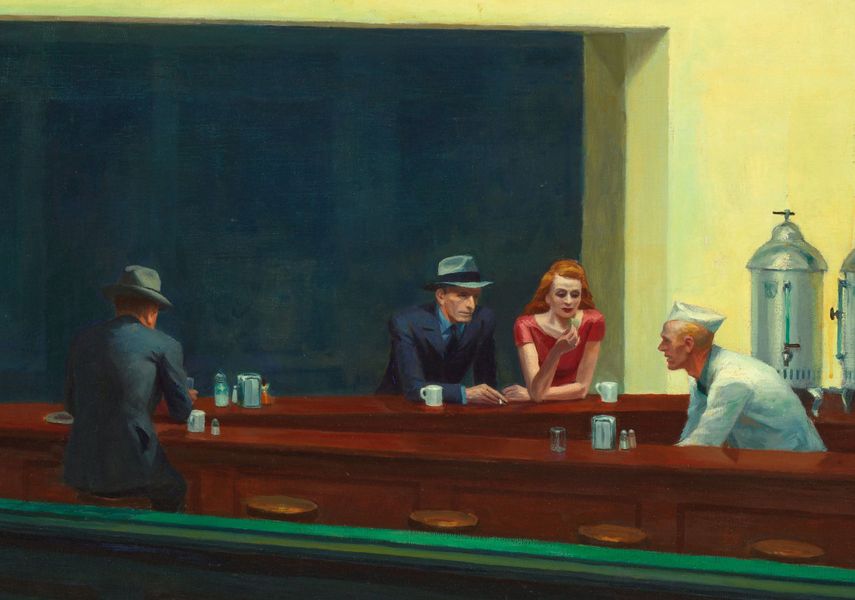What Makes the Edward Hopper Nighthawks Painting so Recognizable?
No artist has ever captured the isolation of an individual within the modern city like Edward Hopper did, exposing the underbelly of human existence. In an interview for Reality Magazine in 1953, Hopper said that “great art is the outward expression of an inner life in the artist, and this inner life will result in his personal vision of the world.“
This intimate and insightful approach is the most evident in his acclaimed Nighthawks painting, an iconic work that has helped define the Modernist movement.
Created in 1942, Edward Hopper’s Nighthawks is considered the incarnation of existential art, capturing the alienation and loneliness symptomatic of modern urban life. While Hopper did not intend to evoke a particular emotional state with his Nighthawks painting, the artist admitted that “Unconsciously, probably, I was painting the loneliness of a large city.” A part of the collection of the Art Institute of Chicago since only a few months after its completion, Nighthawks remains the most requested and sought-after painting in their collection and one of the most recognizable paintings of 20th-century American art.

The Origins of the Nighthawks Painting
A stubborn realist throughout the development of a range of abstract movements, Edward Hopper's paintings are clean, smooth and almost too real. Consistently restrained and subtly suggestive, his paintings invite the viewer to contemplate the narrative. Depicting individuals who were usually isolated and disconnected from their environments, Hopper focused on the solitude of modern life. Suggesting much about his emotional experience as well as the psychological inner lives of his subjects, Edward Hopper led the way toward Abstract Expressionism.
According to the journal kept by Hopper's wife Josephine, the Nighthawks painting was completed on January 21st, 1942, in New York, within weeks following the bombing of Pearl Harbour. For that reason, the work is often seen as an expression of wartime alienation. In this turbulent time in history, when everyone was paranoid about another attack and New York held blackout drills on an ongoing basis as a way to practice hiding the city in darkness in case another aerial assault ever came, Hopper's studio lights stayed on. In her diary, his wife wrote:
Ed refuses to take any interest in the very likely prospect of being bombed.
In January 1942, Josephine wrote a letter to Hopper's sister Marion about the new painting:
Ed has just finished a very fine picture--a lunch counter at night with 3 figures. Night Hawks would be a fine name for it. E. posed for the two men in a mirror and I for the girl. He was about a month and a half working on it.
Edward Hopper's Nighthawks painting depicts four characters sitting in a sparsely furnished diner at night - a woman and three men. A single light source illuminates the diner's interior and spills outward toward the exterior of an empty street where the world seems to have shut down. Placed in ambiguous relationships, none of the four figures in this picture interact with one another. With characters appearing disconnected from each other and the viewer, the Nighthawks painting suggests a chilling revelation that each of us is completely alone in the world.
With its simple setting, dramatic lighting, and ordinary stillness, the painting makes it easy for the viewer to place him or herself into the scene on the city streets. The main character of the work seems to be the diner itself, with strong diagonal lines accentuated by the counter and the stools. However, with no doors to enter, the viewer is shut out from the scene by a seamless wedge of glass, allowing the viewer to invade the diner's private world and his Nighthawks from the street by way of sight only.
As in a classic film noir manner, in Nighthawks, Edward Hopper sets the scene for action that doesn't seem to have taken place yet. Characterized by an open-ended narrative, this painting embodies the artist's interest in the themes of alienation, melancholy, voyeurism and ambiguous relationships.

Edward Hopper's Intense Compositions and Light
In the paintings by Edward Hopper, buildings are often situated at angles to suggest that his subjects are both in front and behind windows. Presenting a separation between the inside and the outside, glasses in the windows seem to be non-existent, inviting a voyeuristic look and suggesting that interiors can be penetrated by gaze. This device is also evident in the Nighthawks painting, where the large window creates an implicit barrier between the viewer and the subjects. The angle at which the diner is set onto the corner allows Hopper to show the people in a mix of frontal and profile views.
Hopper was obsessed with light and the way it fell on houses and people through windows and the colors it made. Yellowish fluorescent light is a substitute for the sun in Nighthawks, emphasizing the artist's understanding of the expressive possibilities of light playing on simplified shapes. The light flooding the diner, the only one illuminating the painting, spills into the night through both windows onto both sides of the street corners. The light causes some of the surfaces within the diner to be reflective, which would not be visible in daylight.
The sign above the cafe advertising cigars for $5 and the cash register seen in one of the windows outside suggest a kind of everyday American experience. The Nighthawks scene is silent and serene, further highlighting the intense feeling of isolation.
Dr. Beth Harris & Dr. Steven Zucker on Edward Hopper's Nighthawks Painting
The Painting of a Universal Quality
A few short months after Hopper put on the final touches, Daniel Catton Rich, director of the Art Institute of Chicago, declared that the work was as "fine as Homer," referencing the 19th-century American landscape painter. He purchased the Nighthawks painting for the Art Institute for $3000 (around $43,200 today), where it remains still.
Hopper said that the painting "was suggested by a restaurant on Greenwich Avenue where two streets meet," additionally noting that he "simplified the scene a great deal and made the restaurant bigger." The public has been trying to locate this particular diner in New York for decades, but after an extensive search, it is concluded that it was never a real place. Many people view it as an apt amalgamation of the ordinary and often overlooked sites that make up a modern city such as New York and so many others.
With its carefully constructed composition, lack of narrative and flat, abstracting planes of color, the canvas has a timeless, universal quality that transcends its particular local, making it an object onto which one can project one’s own reality. Indeed, Hopper's Nighthawks could be seated anywhere. It is in this inherent universality that the power of the painting resides.
An important piece of Americana, the painting also has the ability to evoke a sense of nostalgia for an America of a time gone by. However, Nighthawks by Edward Hopper remains relevant even today as a subtle critique of the modern world, the world in which we all live, where an overwhelming sense of loneliness and a deep desire, but ultimate inability, to connect with those around us prevails.
Editors’ Tip: Staying Up Much Too Late: Edward Hopper's Nighthawks and the Dark Side of the American Psyche by Gordon Theisen
A fascinating study of Edward Hopper's Nighthawks, one of his most celebrated paintings on view at The Art Institute of Chicago, and its deep significance for understanding American culture. It discusses the painting and the central importance of the artist to art history and twentieth-century American culture. Topics include individualism, New York City, Arthur "Weegee" Fellig, diners, pornography, capitalism, advertising, cigarettes, American philosophy, World War II, Gravity's Rainbow, Blade Runner, Pulp Fiction, Russ Meyer, R. Crumb, David Lynch, and film noir. What links these together is the painting's pessimistic take on American culture, which it also seems to epitomize. Despite its desolate feel, this work of art has become a familiar icon, reproduced on posters and postcards, in movies and on television shows. But Nighthawks is more than just a masterful painting. It is a portal into that rarely acknowledged but a pervasive dark side of the American psyche.
Featured image: Edward Hopper - Nighthawks (detail), 1942. All images via Creative Commons.
Can We Help?
Have a question or a technical issue? Want to learn more about our services to art dealers? Let us know and you'll hear from us within the next 24 hours.

